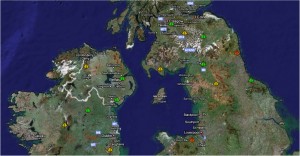Jyri Engestrom, whose company, Jaiku, was bought by Google, talks about social ‘nodal points’. “Social peripheral vision†lets you see what’s next. If you are unaware of other people’s intentions, you can’t make plans. “Imagine a physical world where we have as much peripheral information at our disposal as in WoW.†Not just “boring update … Continue reading “Convergence”
Jyri Engestrom, whose company, Jaiku, was bought by Google, talks about social ‘nodal points’.
“Social peripheral vision†lets you see what’s next. If you are unaware of other people’s intentions, you can’t make plans. “Imagine a physical world where we have as much peripheral information at our disposal as in WoW.†Not just “boring update feeds.†Innovate, especially on mobiles. We will see this stuff in the next 24 months. Some examples: Maps: Where my friends are. Phonebook: what are people up to. Email: prioritized. Photos: Face recognition.
Hands up who heard about ‘Convergence’ in recent years with regards to devices. When I was in Nortel, I was sent a heap of promotional ‘research’ videos about where Nortel thought things were going. Hand held communicators with video, contextual avatars, the ability to switch displays and incoming calls from device to device, display to display. A pocket device which handled communication, driving instructions, meetings, traffic reports, entertainment. In 1997 this was science fiction – and I wish I could find those old MPEGs. In 1997, Nortel was building science fiction, these days they seem to be building golden parachutes.
A decade later and convergence is here. We can do all sorts of magical things with our phones – and the race is on to see which devices will win out but, in the end, it’s all about the software. Some technologies are a certain win – Location Based Services for instance, are going to be insanely popular for games, social networking, media and resource tracking. We’re only seeing the tip of the iceberg at the moment.
In contrast, something that seemed to be a win back in 1997, video-conferencing, has been very slow to take off and I see a lot more people recording or live-broadcasting video to distribution services than I do for point-to-point communication. This may be an issue with devices or it could be an issue with infrastructure. When I had a mobile with a facing camera, I never used it because I didn’t know anyone else who had it or who would be interested in an expensive video conference session. I’ve used video with iChat or Skype a lot because the quality has been very good but tried to use it on my Nokia N800 several times and found it thoroughly dissatisfying.
We need to think about what people really use their mobile phones for.
- Talking to each other
- Sending SMS/texts to each other, sometimes with a picture attached (MMS)
- Email
- Web Search/Sports headlines/Updating facebook/Cheating at pub quizzes
- Playing a game while waiting for something/filling the time while clock watching.
and we need to consider what will be important for them in the future.
In a couple of weeks I’ll be upgrading to a new iPhone 3G and I’m happy with the convergence it brings. For me, the software is important. My partner, however, is vacillating between the new iPhone and going back to a Nokia slide-phone. She prefers the keys and the form factor of the Nokias though she loves her current iPhone.
I find the difference in preference to be interesting. We’re both going to be moving to a 3G phone of some sort.


